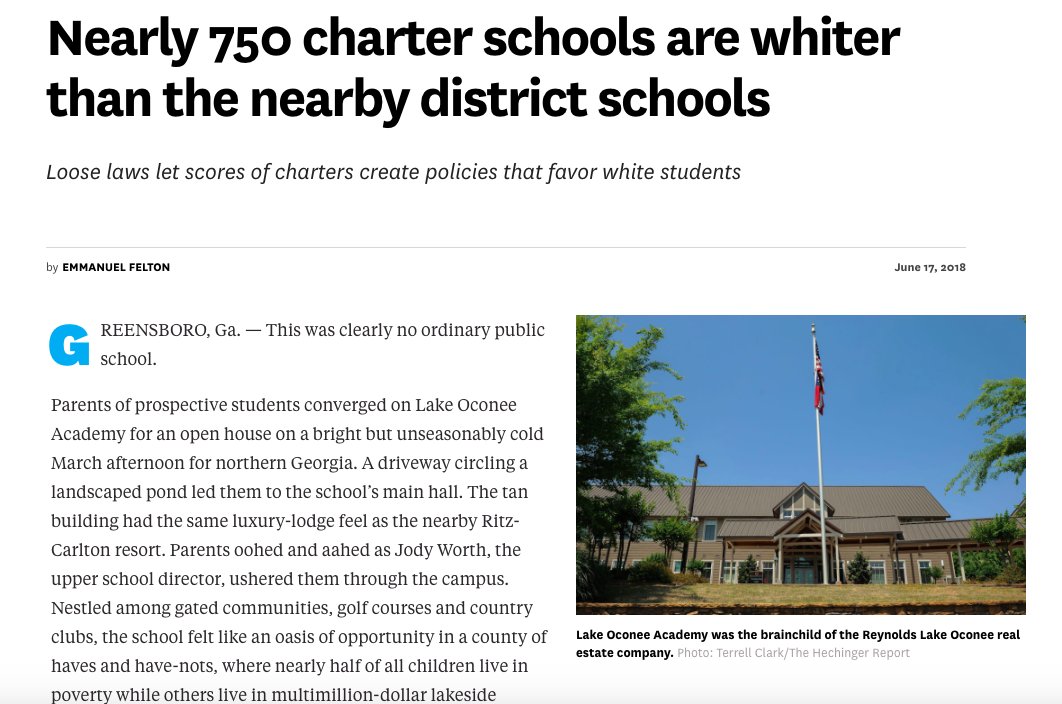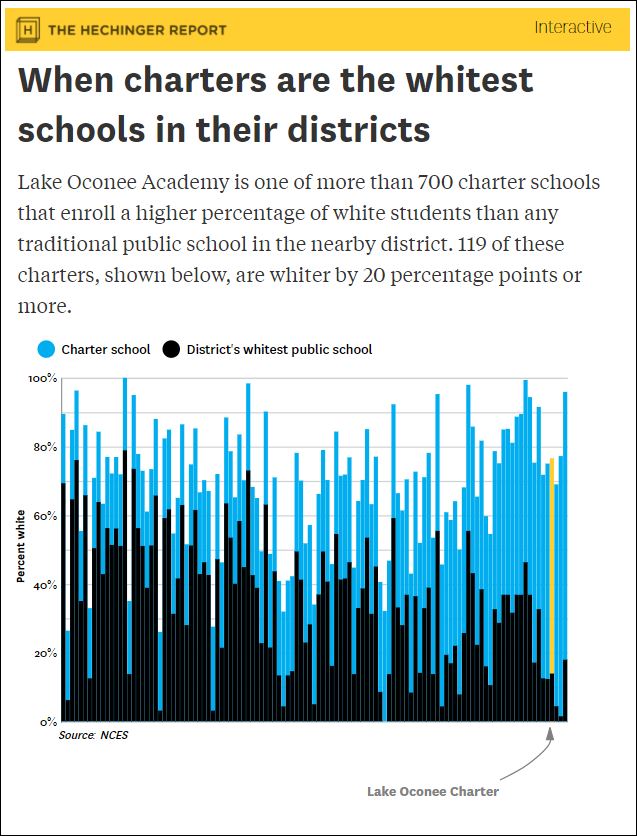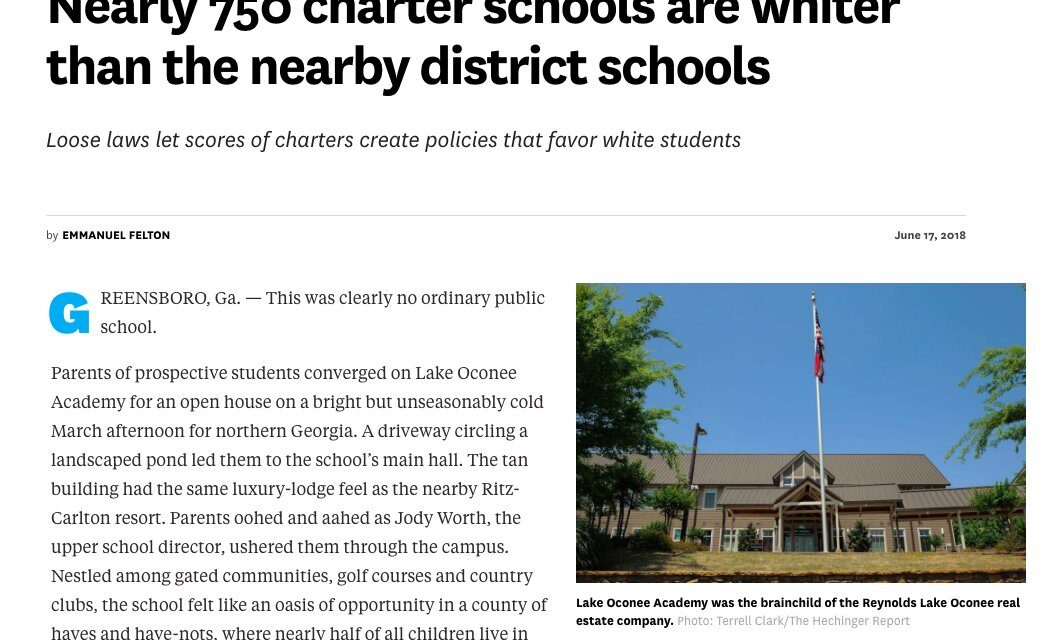A big new piece from the Hechinger Report does a great job revealing an extremely disturbing situation but falls flat trying to make the case for a nationwide trend.
By Alexander Russo
Last week’s investigative piece by the Hechinger Report takes an in-depth look at charter schools like Georgia’s Lake Oconee Academy that are “exclusive, disproportionately white schools.”
The use of charter school laws to create schools like Lake Oconee is disturbing, and the Hechinger Report story, Nearly 750 charter schools are whiter than the nearby district schools, rightly warns that weak state regulation of charter schools could open the door to more of these.
Had it stuck to this school and other schools like it, this piece could have been a big winner.
But unfortunately, the piece fails badly at its larger attempt, which is to assert that this kind of charter school is a significant problem nationally.
Despite all efforts to make it seem otherwise, the data presented in the story do not support the claim that segregated white charters are a big problem.
Lower down in the 5,000-word investigation is the reality that just 115 of 7,500 charter schools are racially identified in this way.
That’s 1.6 percent – a troubling but atypical phenomenon, not a “proliferation” of white charter schools in some states across the country as the Hechinger Report describes it.
The strengths and weaknesses of the Hechinger Report piece are especially clear when you compare it an NBC News version of the same story.
Note: A senior staffer at the Hechinger Report said that the nonprofit did not wish to participate in this piece.
*Correction: Due to an editing error, the original version of this piece reported that the Hechinger Report investigation found 119 disproportionately white charter schools nationwide, rather than 115.

Screenshot of the recent Hechinger Report story.
Now eight years old, the Columbia University-based Hechinger Report often produces strong education journalism.
And what’s going on at Lake Oconee Academy appears to be highly objectionable.
The story, bylined by staff reporter Emmanuel Felton, presents us with a fascinating, creepy tale. The school is the brainchild of a real estate developer looking for ways to attract younger homeowners to his development.
The school has “the same luxury-lodge feel as the nearby Ritz-Carlton resort,” with a circular driveway and pond. There are science labs, sure, but also a piano lab with 25 pianos. And the high school of 200 students offers 17 AP courses.
The basics are paid for by public money as they would be at any public school. The luxuries are largely funded through private donations, and the parents have to volunteer at the school, something that few low-income families can manage.
But at 73 percent white, the school does not at all serve a representative group of students compared to surrounding schools. In fact, the racial gap is 63 percentage points – the fourth-widest in the country, according to the Hechinger Report investigation. The school also serves roughly half as many kids with disabilities and who are English language learners than surrounding district schools.
In other words, the taxpayer is being tabbed for a hefty portion of what amounts to a quasi-private education for the privileged.
The Grade takes a deeper look at education journalism. Sign up here for the free weekly newsletter.

One of the helpful graphics that are part of the Hechinger Report story
I share the outrage that one presumes is behind this piece (or is meant to be its effect). These kinds of schools are definitely worth a story.
The original purpose and defense of charter schools was that they would be used to provide choices to low-income families of color stuck in underperforming schools, or that they would innovate in ways that traditional schools couldn’t. They were not intended to exacerbate segregation or existing inequities in education.
There is some lovely writing – particularly in the description of the school and the parent tour:
“Parents of prospective students converged on Lake Oconee Academy for an open house on a bright but unseasonably cold March afternoon for northern Georgia. A driveway circling a landscaped pond led them to the school’s main hall.”
And there are some helpful graphics showing the schools with the largest racial gaps and the states with the highest numbers of problematic examples.
Where the Hechinger Report story gets into trouble is by claiming that what’s going on at Lake Oconee is a serious national problem.
It does so primarily by using raw numbers and somewhat charged language that makes the problem seem larger than it turns out to be – and by omitting percentages and contextual information that would show that white charters appear to be a small part of the charter scene and the larger school segregation problem.
According to the Hechinger story, there are 750 charter schools that have more white students than surrounding schools. It’s in the headline of the piece.
That sounds like a lot until you realize two key things: That 750 schools make up only about 10 percent of charter schools nationwide, and that the 750 is mostly made up of schools that aren’t all that much whiter.
As it turns out, only 115 of the 750 schools are racially identifiable – meaning there’s at least a 20 percentage-point difference in the proportion of white students. That vast majority – roughly 635 schools – are not. They might be a tiny bit whiter than the surrounding schools. Or a good chunk different. We don’t know. But it’s clear that they all fall below the 20-percentage point threshold that the Hechinger Report is using.
The caveats are there, tucked away in the piece: “The differences between the charters and the whitest nearby public schools ranged from less than 1 percent to 78 percent. These schools represented one in 10 charters operating during the 2015-16 school year.” But they’re not at all emphasized.
But the real problem is the 115 charter schools that are 20 points or more different in terms of student demographics than surrounding schools. And what percent is that of 7,500 charter schools nationwide? That figure is never given in the story. But – you heard this already – it works out to 1.6 percent of charter schools.
Most readers wouldn’t follow a story that made clear from the start that its national problem involved less than 2 percent of charter schools But that’s the story that the Hechinger Report is trying to tell us.
By contrast, the NBC News version of the story, Some elite charter schools disproportionately white compared to districts, produced in partnership with the Hechinger Report, focuses almost entirely on what’s going on at Lake Oconee. There’s a mention of the national numbers. But no real attempt to make the problem appear to be bigger than it really is.
The Grade takes a deeper look at education journalism. Sign up here for the free weekly newsletter.

Screenshot of social referrals for the Hechinger Report story as of Tuesday noon.
Over-emphasizing the size of the “white charter” problem isn’t the piece’s only flaw, or even its biggest one.
The piece also fails to give readers what, for me, is necessary context between charter schools and traditional district schools when it comes to racial segregation.
School segregation is a historical issue in American public education and a major topic of concern right now in traditional school districts. Some communities are trying to secede from larger districts, creating white enclaves. Some districts turn out to have massive within-district racial differences among schools. The enormous and long-lasting racial segregation in places like Ferguson, MO and Boston, MA are the products of traditional school systems.
In fact, many of the criticisms of Lake Oconee Academy such as its student demographics, private foundation, and its reliance on parents to provide expensive extras are features of schools in affluent and often predominately white district schools.
And the Hechinger Report has contributed excellent coverage on school segregation.
Others might disagree that providing larger context is necessary. Charter schools were formed for a particular purpose, and these 115 schools clearly are exacerbating inequities, not narrowing them. It’s its own problem.
But I think there’s a big problem here.
The Hechinger Report story doesn’t tell us much of anything about the larger problem of school segregation.
The piece includes one important acknowledgment, noting that “not all of these schools are necessarily contributing to school segregation.” But the overwhelming focus is on charter school segregation.
In particular, the piece doesn’t give readers the comparable number of traditional schools that fit that 20-point definition of racially distinct.
Is the comparable figure 5 percent of traditional schools? Is it 15 percent? We have no idea.
At worst, this lack of context might be said to create misperceptions among readers about school segregation. Casual readers will come away from this piece thinking that they’ve been told by the Hechinger Report there is a large problem with white charters.
At least, the piece opens the door wide open to mistaken assumptions readers might make on their own. Indeed, the top social media referral for the Hechinger Report story is “Charters more segregated than public schools,” from education advocate Diane Ravitch. As of Tuesday, roughly 500 people have liked or retweeted Ravitch’s mischaracterization of the story.

Parents from the Hechinger Report story.
There are a handful of other concerns:
The descriptions of states with the most predominately white charter schools lacks context that would help readers see, for example, that Michigan has more of a problem percentage-wise than California, even though it’s got fewer charters.
The piece is unnecessarily long and challenging for all but the most dedicated reader. It isn’t until 2,000 words into the piece that we finally meet parents pictured above (Kim Smith, Tasheka Redd, and Sandra Lawson), each of whom has a compelling, nuanced to story to tell had they been given the room.
And the involvement of the Investigative Fund — a nonprofit that’s part of the liberal-leaning Nation Institute – is a red flag for me, given my experience a couple of years ago reviewing a much-corrected story they funded published by The Atlantic.
Related coverage: How Last Week’s Atlantic CUNY Story Went (So) Wrong
But those concerns aren’t as serious as the main problems with this piece, which are that it fails to provide information about the national statistics in a simple and clear way and also neglects to inform the reader about the larger school segregation context.
Presenting raw numbers without percentages is a common problem in news coverage, unfortunately, whether it’s shark attacks, lightning strikes, or school shootings. And this isn’t the first or only attempt to write about charters and segregation that has lacked necessary context.
Issues like white charters shouldn’t have to be big in scale to warrant coverage. We shouldn’t buy into that mindset in which such issues have to be made to seem bigger than they are in order to be considered newsworthy. Focusing more narrowly on the situation at Lake Oconee and its ilk could have made the Hechinger Report version more compelling and effective.
Perhaps unpacking the problems in this one story will encourage journalists to reflect, discuss, and make any necessary changes.
Previous columns focusing on a specific piece of journalism:
In PTA fundraising story, NYT highlights atypical revenue-sharing plan
“Feel-good” story highlights concerns about racial blind spots
Rocky start for ProPublica ‘alternative schools’ series
Previous columns involving the Hechinger Report:
Innovation in education journalism: Experimentation and promise
Despite progress, racial diversity remains a big challenge for education newsrooms
Make education reporting great again
ABOUT THE AUTHOR

Alexander Russo
Alexander Russo is founder and editor of The Grade, an award-winning effort to help improve media coverage of education issues. He’s also a Spencer Education Journalism Fellowship winner and a book author. You can reach him at @alexanderrusso.
Visit their website at: https://the-grade.org/











